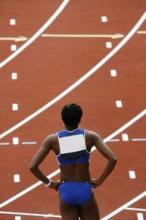Tailored therapy and close supervision may help keep competitive athletes with long QT syndrome, such as Olympic hopeful Dana Vollmer, in the game, a study has shown.
A thorough diagnostic evaluation, appropriate medication, risk counseling, education, and a defibrillator device at the ready kept rates of potentially fatal arrhythmias low among a cohort of athletes who chose to remain in competitive sports despite a diagnosis of the cardiac electrical disorder, Dr. Jonathan N. Johnson and Dr. Michael J. Ackerman of the Mayo Clinic in Rochester, Minn., wrote in the July 21 issue of JAMA.
Their research letter was published online concurrently with a pre-Olympics medical conference in Glasgow, Scotland.
"The issue of long QT syndrome [LQTS] and sports participation has received significant publicity due to reports of sudden death in young, competitive athletes," Dr. Ackerman said in an interview. Additionally, medical eligibility criteria established by two sets of guidelines – those of the 36th Bethesda Conference and the European Society of Cardiology – effectively sideline many athletes, but for those who ignore the recommendations.
To determine the outcomes of patients with LQTS who remain in competitive sports contrary to guideline recommendations, the Mayo investigators reviewed the records of patients who were evaluated at Mayo’s LQTS clinic between July 2000 and November 2010 for athletic participation after LQTS diagnosis and syndrome-related events during a mean follow-up of 5.1 years. Of the 353 LQTS patients aged 6-40 years who were identified, 157 were involved in competitive sports at the Little League, middle school, high school, college, or professional level at the time of diagnosis, and 130 remained in competitive athletics following their diagnosis, including 20 with an implantable cardioverter-defibrillator (ICD), they wrote (JAMA 2012 July 21 [doi:10.1001/jama.2012.9334]).
Of the 130 continuing athletes, 60 were competing contrary to both the Bethesda guidelines and the more-restrictive European guidelines, whereas 70 were continuing in sports contrary to the European guidelines but within the Bethesda recommendations, the authors wrote. The only significant difference between the total cohort and the athletes was age, they reported. The mean age at diagnosis for the continuing athletes was 11 years vs. 17 years for the group overall.
Only one of the continuing athletes – a 9-year-old boy with extreme QT prolongation and a history of aborted cardiac arrest – experienced LQTS-triggered cardiac events during sporting activities. "He received 2 appropriate ventricular fibrillation–terminating ICD shocks, both while warming up before games," the authors wrote. "Each episode occurred in the setting of admitted beta-blocker nonadherence."
All of the LQTS athletes seen during the period of study were managed via the same protocol, which, at the Mayo Clinic, includes providing the patient and his or her family with information to enable them to make an informed decision regarding continued sports participation.
Specifically, according to the authors, this includes a comprehensive clinical and genetic evaluation; a consultation with LQTS experts as needed; extensive counseling regarding individual risks and athletic guidelines; tailored therapy (beta-blockers, left cardiac sympathetic denervation, and/or an ICD); education regarding appropriate hydration and electrolyte replenishment; minimizing elevations of core body temperature; and avoidance of QT drugs. Furthermore, all athletes received an automatic external defibrillator to be kept with their sports gear at all sporting events and practices, and relevant school and athletic officials and coaches were informed of the athlete’s condition, they wrote.
Despite the study’s small sample size and limited follow-up, the low rate of cardiac events per athlete year studied (0.003, or 1 event in 331 athlete years) suggests that exercise and sports participation are "manageable risks" in well-counseled, well-managed LQTS patients, Dr. Ackerman said. "We don’t think it’s necessary to control these risks by telling patients they can’t participate in their sport or get too excited," he said.
However, he noted that limiting sports participation may ultimately be in the best interest of certain patients, depending on their individual situation. In all cases, "patients have to be evaluated, risk-stratified, treated, and counseled carefully. The decision to continue has to be an informed one," he said.
Dr. Ackerman is a consultant for Biotronik, Boston Scientific, Medtronic, St. Jude Medical, and Transgenomic. Dr. Johnson reported having no financial disclosures.


